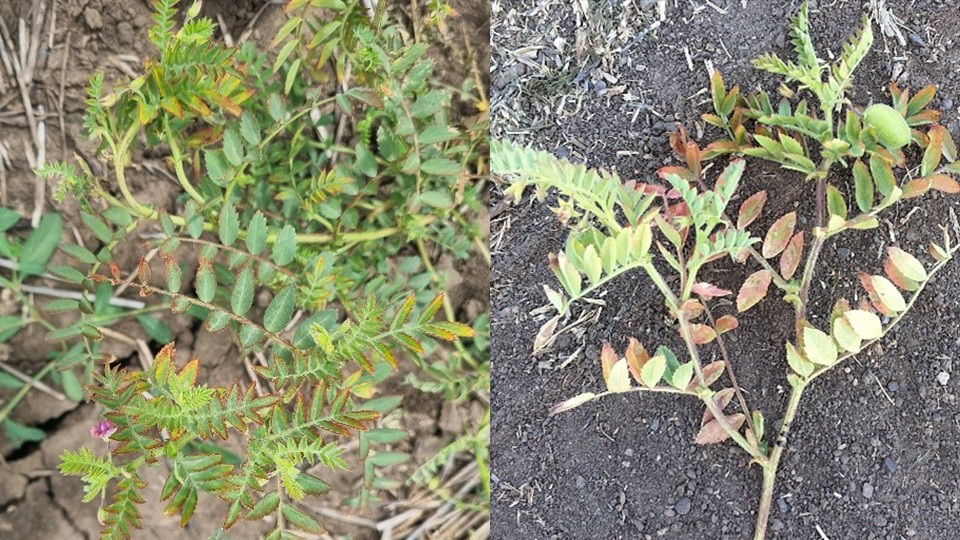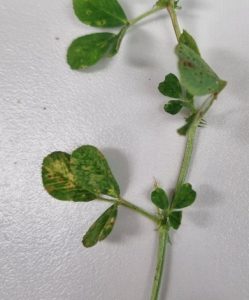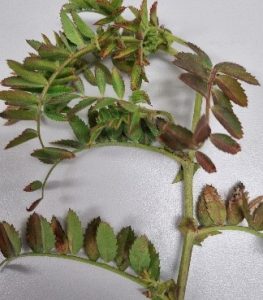A recent survey of chickpea fields across the Darling Downs, including areas around Dalby, Cecil Plains, and Chinchilla, has revealed the presence of several viruses affecting chickpea crops. Among the viruses detected were alfalfa mosaic virus (AMV), phasey bean mild yellows virus (PBMYV), turnip yellows virus (TuYV), and bean leaf roll virus (BLRV).
Alfalfa mosaic virus (AMV)
AMV was the most prevalent virus detected in this year’s survey, with 14 out of 15 fields showing moderate to high levels of infection. It was also found at one site in burr medic plants growing next to a chickpea field. AMV is a non-persistent virus, meaning aphids that transmit the virus remain infective for only a short period (a few minutes to a few hours). It is spread by a variety of common aphids, which transfer the virus from seed-infected plants to healthy plants.

Chickpea with AMV (left) and a plant with a more advanced infection (right)
While AMV can be transmitted through seed, the recorded seed transmission rates in chickpea are low (0.1–1%). The virus is commonly found in lucerne and weeds such as burr medic (Medicago polymorpha), common sowthistle (Sonchus oleraceus), clover (Trifolium species) and blackberry nightshade (Solanum nigrum).
Symptoms to look for in chickpea:
- Shoot tip necrosis
- Reddening of leaf edges
Other viruses

Burr medic with AMV and PBMYV
The viruses below are all transmitted persistently by aphids, meaning aphids remain infectious for life after acquiring the virus from an infected host.
Phasey bean mild yellows virus (PBMYV) was detected in 9 fields. The main weed host for PBMYV is phasey bean (Macroptilium lathyroides).
Turnip yellows virus (TuYV) was found in 2 fields, primarily around Dalby. It is transmitted by green peach aphids (Myzus persicae) and has an extensive host range, including wild mustard.
Bean leaf roll virus (BLRV) was detected in just 1 field east of Chinchilla. It is transmitted by several aphid species, with pea aphid (Acyrthosiphon pisum) being the primary vector. BLRV hosts are limited to the Fabaceae (legume) family, including weeds such as clover.
Symptoms of PBMYV, TuYV, and BLRV in chickpeas
The symptoms of these viruses vary depending on the chickpea variety:
- Kabuli chickpeas: Pale, chlorotic leaves and stunting
- Desi chickpeas: Purple-red leaf discolouration
Managing viruses in chickpea crops

Chickpea with AMV and TuYV
Effective management of chickpea viruses relies on reducing the presence of virus host plants and aphids. Key strategies include:
- Controlling weeds and self-sown volunteer crops that can harbour aphids and viruses between cropping seasons.
- Sowing chickpeas into cereal standing stubble to reduce aphid landing rates.
- Removing infected chickpea plants to limit virus spread (ideally after virus testing, as symptoms can resemble other issues such as nutrient deficiencies).
- Monitoring crops regularly to assess aphid levels.
Note, insecticides should only be applied if aphid numbers are high.
Questions or sample submissions?
If you’re seeing symptoms or have concerns about viruses in your crop, contact Fiona Filardo at the Department of Primary Industries (DPI) Queensland:
📞 [07] 37088449
📧 [email protected]
This initiative is part of the GRDC and QLD DPI-funded project DAW2305-Effective virus management in grain crops.
